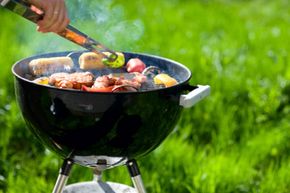If you love grilling, you probably have a man named George Stephen to thank for those burgers, steaks and brats that make weekends at your house so delicious.
The Brazier Grill
Advertisement
During the late 1940s and 1950s, returning servicemen and their families started a migration to the suburbs, and all that outdoor space called for outdoor pastimes, including some experimentation with open-air cooking.
The forerunner of the modern grill was a shallow sheet-metal pan sitting atop spindly legs and, in the case of deluxe models, a set of small wheels. It was called a brazier grill and was effective at heating charcoal, but didn't provide much control over the cooking process.
Brazier grills were open to the elements and had no vents, which often made grilling a dicey proposition. Standing around one in a stiff breeze was a bit like being in an ash storm, with the added thrill of an occasional red-hot ember flying your way. They were an entertaining and inexpensive novelty, but food cooked with them often ended up incinerated on the outside and raw on the inside. For someone who wanted a serious outdoor cooker that could grill a consistently superior product, brazier grills weren't the answer.
Weber to the Rescue
Fast-forward a few years to Mount Prospect, Ill., in the early 1950s where George Stephen, Sr., a worker at the Weber Bros. Metal Spinning Company, had a historic aha! moment. Stephens, a dedicated backyard cook himself, envisioned a more efficient and all-around better grill using the design of the harbor buoys Weber was producing at the time. His original idea was to cut a metal buoy in half, install vents, add a grate to the bottom section and top it off using the second half of the buoy as a lid. By implementing these changes, he created a covered vessel that would provide more control over the cooking process and produce a superior grilled product [source: Weber-Stephen Products].
The release of the first Weber kettle grill in 1952 started a revolution in outdoor cooking, and the unmistakable silhouette of this backyard favorite has become synonymous with charcoal grilling [source: Food Network].
Grilling Enhancements
Since the production of the innovative Weber grill, open-air cooking technology has made some notable strides. The introduction of gas-powered grills made it possible to cook meat fast and at reliably stable temperatures, while high-powered, heavy-duty models have extended the grilling season to virtually year-round.
For those who like the taste of grilled food but don't really care for the alfresco approach, the 1994 introduction of the George Foreman grill, an electric grilling station, made it easy to enjoy the advantages of grilling from the relative comfort of the indoors. Capitalizing on this trend toward grilling and away from frying and broiling, newer range setups often have the option of added onboard grilling stations as well, an indication of how indispensable this cooking method has become [source: George Foreman].
Grilling can make meat, poultry, fish, veggies and even fruit taste devilishly good, so the next time you see grill marks on your food, take a moment to say a silent thank you to George Stephen, the man who introduced quality grilling to the 'burbs.
Advertisement
